Hummingbirds love spaces in the forest, thus suburban and rural gardens with a combination of giant trees, bushes, and areas of meadow and lawn are attractive to them. They are less likely to visit cities, maybe because there are fewer blooming plants and trees for food and nesting. Let’s check out how to attract hummingbirds to your garden.

Hummingbirds frequent parks and occasionally visit window boxes or rooftop gardens decorated with brilliant blooms, even in the largest cities, especially during migration. Hummingbirds are extraordinary creatures of habit, and once they’ve discovered your property, the same ones are likely to come back each year at the same time. The population of hummingbirds in your garden is directly proportional to the availability of food, water, nesting locations, and perches.
What plants attract hummingbirds the most?
Flowers that are orange or red in color and tube-shaped are some of the best for attracting hummingbirds to the garden. Bee-balm, Columbine, Cardinal flower, and Jewelweed are examples of native American wildflowers that inherently lure hummingbirds.
Hummingbirds also explore a variety of other flowers in the garden, including lilies of different varieties. Scarlet sage, Daylilies, Honeysuckle, Cannas, Bouncing bet, Silk tree, Spider flower, Morning glories, Petunias, and Fuchsias are just a few of the perennial plants and trees that attract hummingbirds.
Planning your hummingbird garden
Draw a layout of your garden, including the home and any structures such as garages or tool sheds. Include trees, bushes, existing flower beds, and other hummingbird-friendly characteristics. Work with what you’ve got and make it better by adding more plants. Find a nice site to be the focal point of your hummingbird garden using your layout sketch. You’ll have a front-row seat to the action if you sit near a window or patio door.
In case you miss this: Top 20 Garden Plants That Attract Pollinators to Your Garden
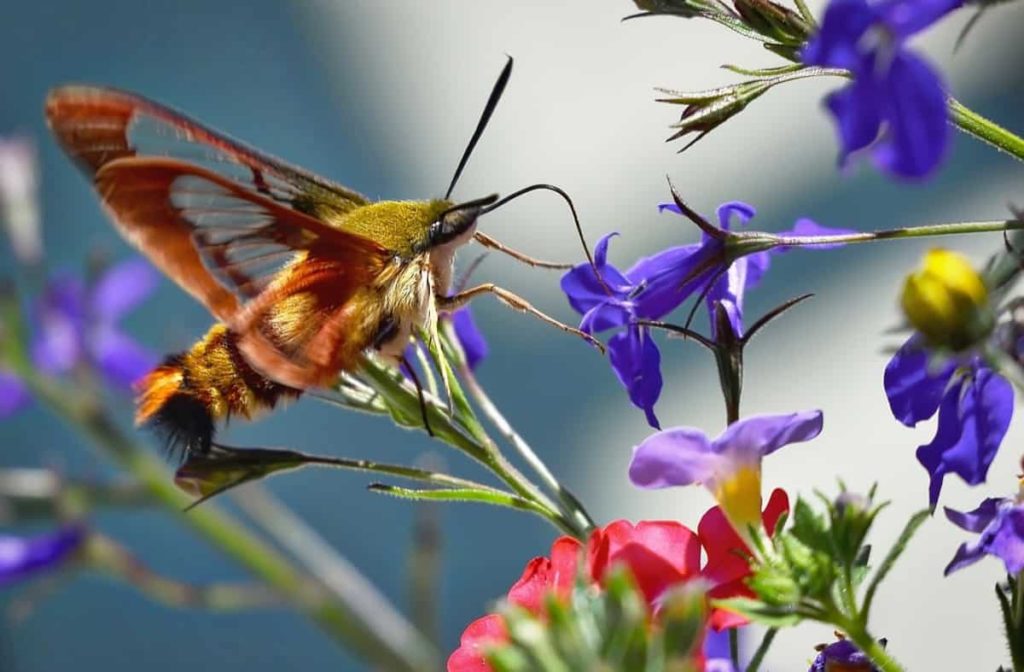
Hummingbird gardens don’t have to be elaborate; a flower box or trellis can suffice. Hummingbird-friendly landscapes will attract more birds, but even a few select plants added to existing gardens may provide food for some hummers. When designing a hummingbird garden, consider vertical gardening too. Support climbing vines using trellises, trees, garden sheds, or other structures; create a tiered look with window boxes, wooden tubs, or ceramic pots to give growth spaces for a wide range of plants.
How to meet the basic needs of hummingbirds?
The layout must contain ways to fulfill all four of Hummingbird’s fundamental demands, regardless of the size of the hummingbird garden you choose to create.
Water
Hummingbirds are less interested in a deep bath or a fast stream, but misters, drippers, and small basins are good water sources. Hummingbirds will bathe by rubbing on wet foliage if broad-leafed plants are arranged in such a way that water may pool on the leaves.
Food
Hummingbirds are nectarivorous, but they also eat a lot of bugs, especially while breeding, when insects provide an important source of protein for the hatchlings’ development. Hummingbird gardens should have nectar-rich flowers and extra hummingbird feeders, and the garden should be kept in an insect-friendly manner.
Shelter and nesting
Even in a modest hummingbird garden, trees are required to offer ample perches and shaded regions secure from predators or inclement weather. Dwarf or decorative tree kinds are beautiful alternatives that may be used in almost any setting, and bigger mature trees placed close are also helpful.
Hummingbirds do not use typical birdhouses since they do not nest in cavities, but they will have plenty of alternatives for nesting in safe areas with plenty of trees. Hummingbirds may build nests on clotheslines, wires, and other strange places, and spider webs should not be cleaned and must be left for nesting.
In case you miss this: DIY Garden Decor Ideas
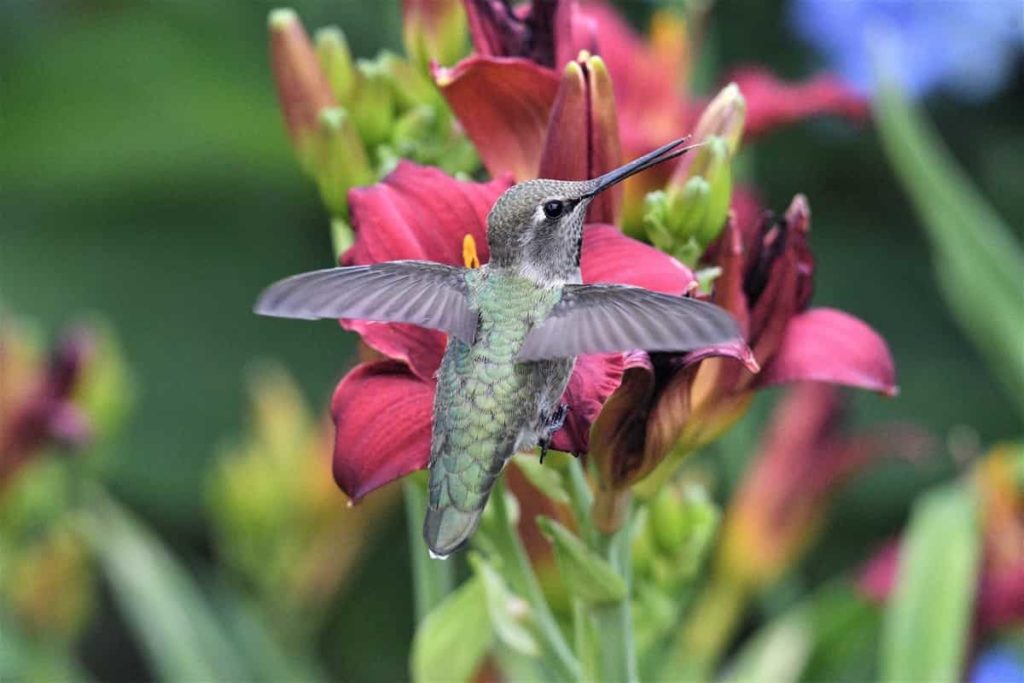
How to attract Hummingbirds to your garden
Selecting of native plants
Choose plants that are native to your area for your garden. Learn about the plants that hummingbirds eat in nearby natural places. Native hummingbird plants and native hummingbird species have a long history of working together to provide a steady source of nectar at the same time every year.
Keep in mind that while cultivated kinds of impatiens and rhododendrons may appear appealing to hummingbirds, they are not good nectar providers and are chosen for flower size, color, and form. Planting exotic blooming plants like Japanese and Tartarian honeysuckles, which attract hummingbirds but expand on surrounding fields and forests, pushing out more valuable native shrubs and wildflowers, is not a good idea.
Colours play an important role
Select red and tubular flowers since they are early indicators of a flower’s worth as a hummingbird food source. Orange and pink flowers are also appealing to hummingbirds, while yellow and white blossoms are not. Hummingbirds can be attracted to red, non-tubular flowers like roses and geraniums by their blossoms, but because they provide little nectar, the birds swiftly reject them. Hummingbirds do not depend on nectar from flowers that rely on pleasant fragrances to attract insect pollinators.
Arranging the garden to attract hummingbirds
Plants should be strategically placed to produce a tiered effect that allows birds to access additional food sources while not compromising the greatest views. Taller plants and trees should be placed in the bed’s center or rear, with shorter plants and mounding variety in front.
Plants with comparable watering and fertilizing requirements can be grouped to make maintenance easier. Add some fuzzy plants to the mix. Hummingbirds use soft plant fibers to line their nests. Cinnamon fern, which has a fluffy stem, and pussy willow are two favorites. Add some thistle and dandelion, two additional popular nest-building plants, in your yard.
Adding to the Hummingbird Garden
Include room in your hummingbird garden for hummingbird feeders, water sources, and nesting material to make it a one-stop shop for these flying gems. These items can also be useful for capturing wonderful views of hummingbirds when they return to the same location. If there are no trees or bushes in your garden and none nearby, place perches within 10 to 20 feet of the garden. Use a fallen branch with little twigs as a replacement for a live perch.
Perches, springboards for courting displays, and nests are all common uses for large trees. Hummingbirds may also get lichens off the trunks of huge trees, which some species use to decorate the outsides of their nests with spider silk. Plant a huge tree, such as a maple or oak, if space allows. Grow small trees that can act as nesting locations and sources of food if you have a small yard.
In case you miss this: Flower Gardening In Colorado, Planting Guide
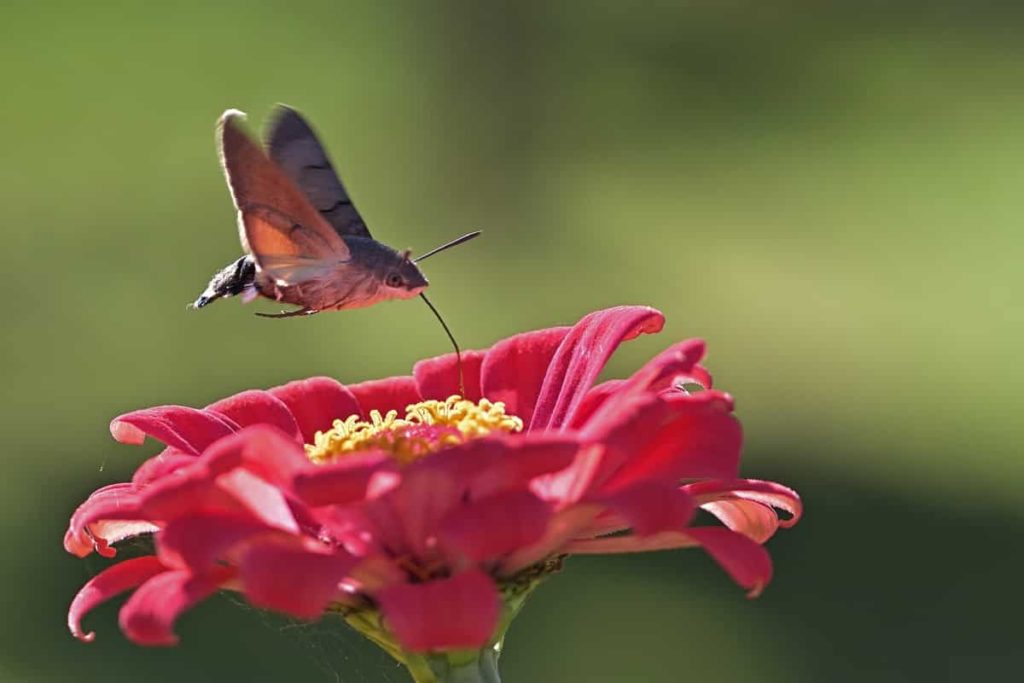
Avoid insecticides for plants
Insecticides should be avoided. When hummingbirds eat insects, they can swallow toxins, and systemic herbicides can also be present in flower nectar.
Proper care and maintenance are required for a hummingbird garden
Hummingbird gardens don’t require much maintenance, and the birds aren’t picky about trimming, weeding, or other garden duties. Nonetheless, modest maintenance might help hummingbirds enjoy the garden even more. As much as possible, avoid using chemicals. Herbicides and insecticides, even at trace levels, can taint nectar and kill hummingbirds. Chemicals will also remove numerous insects that hummingbirds require.
Compost may be used to nourish plants and protect the soil. It will support insect life, which hummingbirds will enjoy. Compost will help enrich the soil with nutrients, allowing plants to produce more blossoms for a natural nectar source. Flowers should be properly cared for to stimulate reblooming and so continue to feed hummingbirds throughout the season. This may need some trimming, deadheading, or other methods of extending the life of the blooms.
Keep an eye out for hummingbird predators and use barriers, protected perches, and other methods to keep the garden secure. Make an effort to keep wild cats and other unwanted visitors out of your hummingbird garden.
Along with hummingbirds, take measures to attract butterflies and hummingbird moths. Hummingbirds and butterflies have a lot in common, and plants that are good for butterflies are also good for hummingbirds. These insects will aid in the pollination of flowers, allowing hummingbirds to consume even more blossoms.
In case you miss this: Growing Organic Sage – In Containers, And Pots
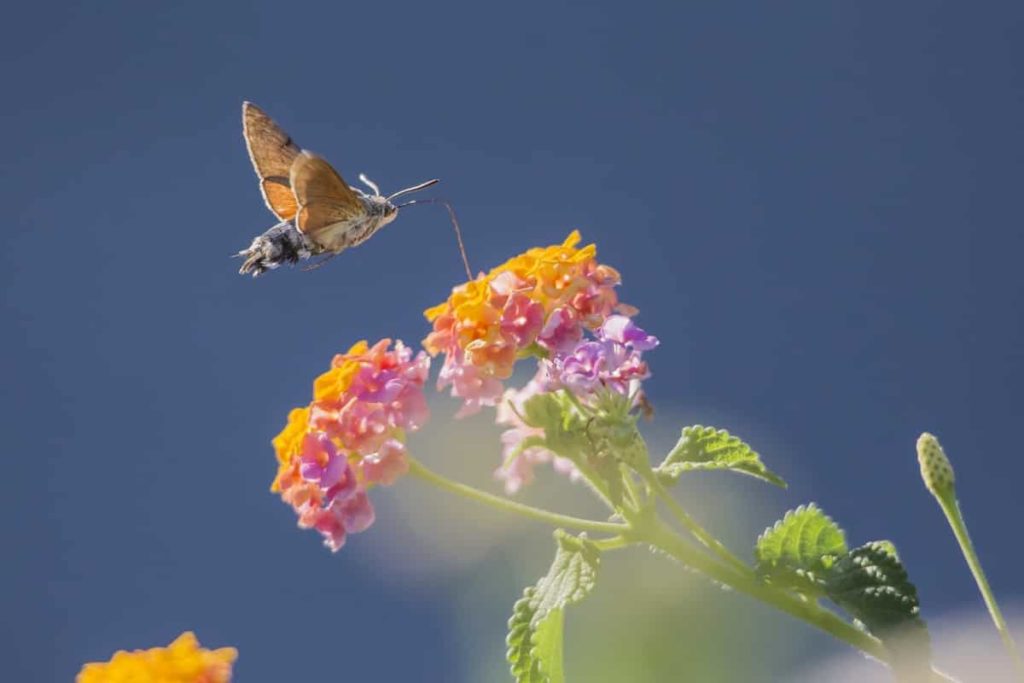
Additional tips for growing a hummingbird garden
Hummingbirds need a place to rest and cover from predators and the elements, so plant trees and bushes near the feeding area. Hummingbirds prefer ripe fruit near the feeding location because it attracts gnats, which are an essential protein source for hummingbirds. Hummingbirds require water as well. Hummingbirds can drink from a birdbath that is no more than 4 cm deep. Fill the bottom of the bath with fine pebbles if it is too deep.
Only a small portion of a hummingbird’s dietary requirements are met by nectar. For the protein they give, several animals consume vast numbers of tiny bugs. A modest weedy patch or wildflower area might attract pests to your garden. Insecticides should never be used in gardens where hummingbirds eat.
Flowers with long necks that dangle in groups beyond the leaves are the finest for drawing hummingbirds. Hummingbirds are forced to beat their wings against the leaves while they feed if the flowers are too near to the foliage. At any given moment, the plants must have numerous open flowers.
Be persistent when it comes to hummingbirds
Don’t give up. Hummingbirds can arrive minutes after you place enticing plants in your yard, but it may take several weeks for them to notice you. Even if you use gorgeous red blossoms as a lure, pure luck could keep your feeder hidden until the first migrant notices it.
Once hummingbirds arrive in your garden, they will most likely stay for the entire season, and they will generally return the following year. When your hummingbird visitation drops down for a week or two in the middle of summer, a particularly appealing neighboring flower patch may have momentarily distracted your hummingbirds.
In case you miss this: Low Maintenance Plants for Indoor Garden
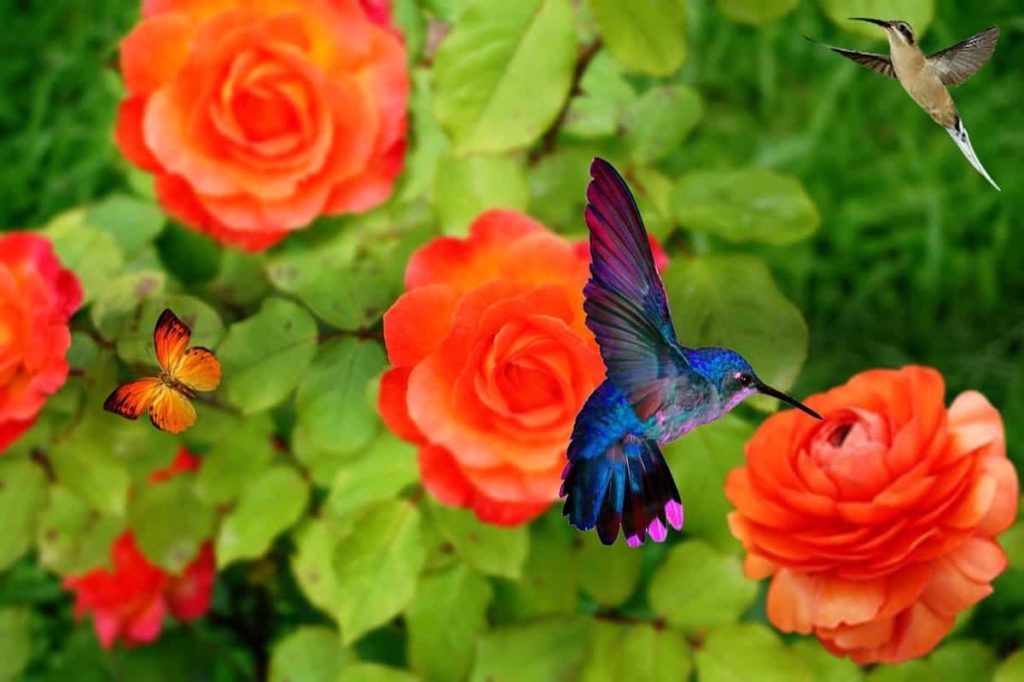
Frequently asked questions about hummingbird garden
What time of day do hummingbirds feed on plants?
Sunrise and sunset, or early morning and late afternoon before sunset, are the most favorite times for hummingbirds to approach a feeder and feed upon the nectar. Hummingbirds will be spotted eating at numerous times throughout the day, even though those two periods appear to be their preferred times to eat.
How long until hummingbirds find my feeder?
As mentioned above, be persistent. You’re not going to install a feeder or plant a few flowers and have dozens of hummingbirds arrive out of nowhere. Hummingbirds may take days, weeks, or months to locate your garden and begin coming regularly.
Should hummingbird feeders be in sun or shade?
You may also assist keep nectar fresh by keeping your feeders out of direct sunlight. Passing hummingbirds have a hard time seeing the feeders because of the deep shade. Instead, look for a position with dappled shade or one that is shaded during the hottest part of the day.
Do hummingbirds visit the same feeder year after year?
Humming can return to the same feeder year after year since they have a wonderful memory. Hummingbirds may go hunting for food elsewhere if these feeders are not available, never to return. True, our small companions are devoted to us, yet they cannot survive for more than a few hours without nectar.
- Flower Garden Designs and Layouts for Beginners
- Planting and Spacing Techniques in Papaya: A Beginner’s Guide
- Growing Gold: Essential Techniques for Planting Pineapples
- How to Make Kalanchoe Plant Bushy: Home Remedies and Solutions
- 11 Reasons Why Your Gardenia is Not Blooming: Home Remedies and Solutions
- Eco Elegance: The Guide to Designing a Drought-Tolerant Landscape
- Gardening on a Slope: Strategies for Hillside Landscaping
- Nourish and Flourish: Top Organic Mulches for Thriving House Plants
- Everything You Want to Know about Indian Mogra Flower: Discover Uses and Growing
- Green Thumb Success: Expert Tips for Cultivating Greenhouse Pumpkins All Year Round
- Maximize Growth & Flavor: The Ultimate Guide to Companion Planting in Herb Gardens
- How to Control Rhododendron Problems Naturally: Home Remedies and Organic Ways to Fix Them
- Natural Magic: The Remarkable Benefits of Cinnamon for Plants
- Best Steps to Revive Dying Tulip with Natural and Organic Treatment
- 10 Reasons Why Your Angel Trumpet is Not Blooming: Remedies and Treatment
- How to Fix Periwinkle Leaf and Flower-Related Problems: Natural Remedies and Solutions
- How to Fix Zinnias Leaf and Flower Problems: Discover Natural and Home Remedies
- Organic Steps to Induce Lemon Tree Flowers: A Comprehensive Guide
- Bloom Booster: Crafting the Perfect Homemade Bougainvillea Fertilizer
- Optimizing Growth: A Guide to Applying NPK Fertilizer for Potted Plants
- 10 Best Homemade Fertilizers for Rubber Plant: DIY Recipes and Application Method
- How to Boost Female Pumpkin Flowers: Effective Steps for More Flowers and High Yields
- Transform Your Indoor Garden: Top Benefits of Pink Salt for Houseplants
- 10 Best Homemade Fertilizers for Peacock Plants (Calathea): Easy DIY Guide
- Unlock Blooms: 9 Reasons Why Your Potted Chrysanthemum is Not Blooming
- 8 Reasons Why Your Potted Hibiscus is Not Blooming: Fix it with Simple Solutions
- Unlock Blooms: 9 Key Reasons Your Potted Frangipani Won’t Flower
- 10 Reasons Why Is My Ice Plant Not Blooming: Remedies and Treatment
- 10 Reasons Why My Potted Hydrangea Not Blooming: Treatment and Remedies
- 10 Reasons Why is My Wisteria Not Blooming: Remedies and Treatment
- 10 Reasons Why is My Goldfish Plant Not Blooming: Remedies and Treatment
- Maximize Your Space: Ultimate Guide to Balcony Gardening with Grow Bags
- 10 Reasons Why Your Iris is Not Blooming: Remedies and Treatment
- 10 Reasons Why Your Anthurium Plant is Not Blooming: Treatment and Remedies
- 10 Reasons Why Your Aquaponic Plants Are Not Flowering: Remedies and Treatment
- 10 Reasons Why Your Agapanthus is Not Flowering: Remedies and Treatment